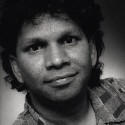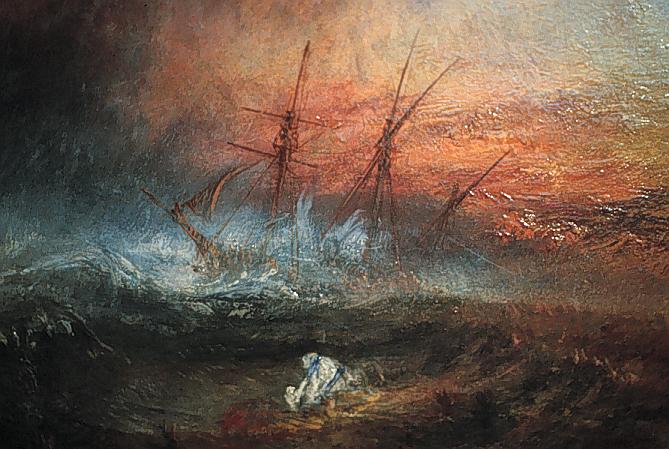|
Lecture 4 David Dabydeen, Turner (2002) |
|
Biographical information: http://www.poetryinternational.org/cwolk/view/15897
"Dabydeen's
long poem Turner was inpired by the painting
Slave Traders Ditching the Dead and the Dying with
Hurricane Approaching by the English painter William
Turner (1775-1851). John Ruskin, the famous art critic,
possessed this picture for a while, but he found the
scene so horrifying that he traded it for another
painting. The horror is certainly part of Dabydeen's
600-verse poem. It tells the story of a still- or nearly
still-born child of a slave girl and a slave-trader
captain, a little boy thrown overboard and either
drowning or surviving, either below or above the sea's
surface, coming ashore from time to time and living the
life of a slave, or joining the followers of an African
prophet."
|
|
2 Joseph Mallord William Turner (1775-1851) |
|
J.M.W. Turner: The Slave Ship (1840), Boston Museum of Fine Arts Another version of the image (detail): Link: http://www.scottzagar.com/arthistory/timelines.php?page=event&e_id=1412
|
|
6 TOPICS |
|
1. The Slave Trade, the British system of indentured labour, and Dabydeen's ancestry as well as sense of implicatedness in the colonial context. From the latter part of the fifteenth century, the Portuguese and the Spanish, followed by the British, the Dutch, and the French, set up a thriving slave trade between the Atlantic coast of Africa and markets for slave labour in the Americas and the Caribbean. Herbert Klein estimates that this trade transported over 9 million Africans to the Americas between 1662 and 1867 (1999: 208-9); John Iliffe puts the figure for the entire period from 1450 to 1900 at over 11 million (1995: 131), as does Johannes Postma (2003: 35-6). Of these, over 5 million were exported by carriers from Portugal and Spain, and over 3 million by carriers from Britain. Over half of the total number was shipped in the eighteenth century. Ten to twenty percent died in the crossing. By the middle of the nineteenth century, the population of Africa was about half of what it might have been without the slave trade. Britain, the nation that profited the most from the trade, abolished commerce in slaves from 1807, and passed an Act of Abolition in 1833 (the French followed in 1848, the Spaniards in 1886). 2. The tradition of landscape painting; the topographical tradition in English poetry: their role as remote background for the painter and the poet. Grove's Online Dictionary of Art: The concept of the Sublime: http://www.joh.net/phd/appendices/texts/sublimegove.html The Tate Online: Sublime Landscape http://www.tate.org.uk/servlet/CollectionDisplays?roomid=1904 3. The sublime: its Romantic manifestations and its treatment by Ruskin. THE SUBLIME: a definition/description of the term. The Victorian Web site on "The Sublime": http://www.victorianweb.org/philosophy/sublime/sublimeov.html George P. Landow on Ruskin and the Sublime: http://www.victorianweb.org/authors/ruskin/atheories/3.1.html "Turner, whose deathbed utterance is reputed to have been "The Sun is God," clearly held the views about light and color which his chief advocate attributed to him (Quoted by Lindsay, Turner, 213). In particular, the painter employed color with precise allegorical or symbolical intentions. The first volume of Modern Painters describes the "crimson and scarlet" of The Slave Ship as a judgment upon the guilty vessel: "It labours amidst the lightning of the sea, its thin masts written upon the sky in lines of blood, girded with condemnation in that fearful hue which signs the sky with horror, and mixes its flaming flood with the sunlight, and, cast far along the desolate heave of the sepulchral waves, incarnadines the multitudinous sea" (3.572). In the notes to the Turner Bequest he points out that the lines the artist appended to War, another crimson work, "are very important, being the only verbal expression of that association in his mind of sunset colour with blood . . .:
'Ah, thy tent-formed shell is like Turner and the Sublime: http://www.victorianweb.org/philosophy/sublime/turner.html Turner and the Sublime: The natural sublime: http://www.liverpoolmuseums.org.uk/walker/exhibitions/turner/sublime.asp 4. The modern/postmodern perspective on the sublime: Lyotard; Theodor Adorno's notion: "no poetry after Auschwitz"; Walter Benjamin's notion that all documents of culture are also documents of barbarism: the application of such ideas to the esteem in which Turner is held in England.
5. The notion of "naming" as a form of "interpellation" : the projection of an identity on someone through one's naming of that person in this or that way. Interpellation: http://faculty.uwb.edu/mgoldberg/courses/definitions/Interpellation.html Prosopopoeia or personification: http://www.litencyc.com/php/stopics.php?rec=true&UID=906
|
|
7 Review Questions |
|
1. To what extent can we say that Turner has already "deconstructed", or "pre-empted" Ruskin, or Dabydeen's objections to Ruskin? 2. Why is the notion of "the sublime" inadequate or problematic in relation to Turner's painting? 3. Greek rhetoric describes "naming" as prosopopoeia or personification. How does "giving names" become crucial to Dabydeen's poem? What does it accomplish? 4. What is Dabydeen's relation to, or personal involvement in, the Slave Trade or its consequences as refracted by the painting? 5. What is the ethical or moral drive underlying Dabydeen's treatment of Ruskin-Turner?
|
|
Last Updated 23 February 2012 |


